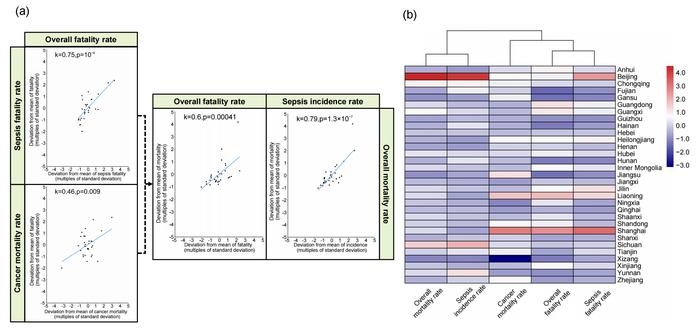Nationwide study reveals burden and geographic patterns of sepsis among hospitalized non-child cancer patients in China
Sepsis, a life-threatening complication of infections, poses a severe threat to cancer patients, whose compromised immune systems make them highly susceptible. In a study published in Science Bulletin, researchers led by Hong-Da Chen from the Peking Union Medical College Hospital, Chinese Academy of Medical Sciences and Peking Union Medical College have firstly revealed the substantial burden and geographic disparities of sepsis among hospitalized non-child cancer patients in China.

Credit: ©Science China Press
Sepsis, a life-threatening complication of infections, poses a severe threat to cancer patients, whose compromised immune systems make them highly susceptible. In a study published in Science Bulletin, researchers led by Hong-Da Chen from the Peking Union Medical College Hospital, Chinese Academy of Medical Sciences and Peking Union Medical College have firstly revealed the substantial burden and geographic disparities of sepsis among hospitalized non-child cancer patients in China.
By analyzing a nationwide database of hospital admissions in 2017, the researchers found a high incidence rate of 2,793 sepsis cases per 100,000 hospitalized non-child cancer patients, which is 8.2 times higher than the overall sepsis incidence in China. Notably, the in-hospital mortality rate due to sepsis among these patients was 412 per 100,000, more than double the overall mortality rate of non-child cancer patients in China. The study also revealed significant gender disparities, with males exhibiting higher sepsis incidence, case fatality, and mortality rates compared to females. Specifically, the age-standardized incidence rate for males was 4,118 cases per 100,000 cancer admissions, while for females it was 1,906 cases per 100,000 admissions. The standardized mortality rate was 612 per 100,000 cancer admissions for males and 273 per 100,000 for females.
Furthermore, the researchers uncovered substantial geographic variations in sepsis burden across China. The overall in-hospital mortality rate was strongly correlated with sepsis incidence rates rather than case fatality rates, indicating that differences in sepsis occurrence, rather than survival after admission, primarily drove the geographic distribution of sepsis deaths among cancer patients. Interestingly, the study revealed a U-shaped relationship between sepsis incidence and mortality rates and the Human Development Index, wherein regions with relatively lower and higher development levels exhibited elevated rates compared to areas with intermediate development status.
This large nationwide study is the first to report the in-hospital incidence, case fatality, mortality, and geographic distribution of hospitalized sepsis among non-child cancer patients across China.The researchers emphasize that targeted strategies, such as improving access to sepsis screening and treatment, enhancing infection control measures, and strengthening healthcare infrastructure in resource-limited areas, could potentially mitigate the burden of sepsis among cancer patients.
###
See the article:
Overall and geographic pattern of incidence, fatality and mortality of sepsis among hospitalized non-child cancer patients in China: a nationwide cross-sectional study
https://doi.org/10.1016/j.scib.2024.03.050
Journal
Science Bulletin
DOI
10.1016/j.scib.2024.03.050.